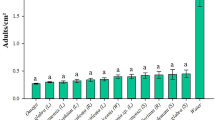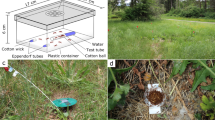Abstract
A bioassay was developed to determine whether treatment with essential oils thymol, methyl salicylate and carvacrol can reduce the oviposition rate of western flower thrips (wft), Frankliniella occidentalis, on plum blossoms. Individual field-collected wft females were confined on single blossoms treated with three concentrations of essential oils applied in different suspensions: an aqueous 0.05 % Triton X-100 plus ethanol solution [ethanol/water/Triton (EWT)], an EWT plus Citrex® medium mineral oil and an aqueous 0.05 % Triton X-100 solution (water/Triton) plus Citrex®. The number of eggs laid per female over 24 h was compared to oviposition on untreated blossoms and those treated with control suspensions. A 10 % suspension of thymol significantly reduced oviposition rate by 85 % compared with blossoms treated with control suspension and untreated. Methyl salicylate concentrations of 10 and 1 % significantly reduced oviposition rate by 84 and 88 %, respectively, compared with the control suspension and, 89 and 85 %, respectively compared with the untreated. Carvacrol concentrations of 5, 1 and 0.1 % significantly reduced oviposition rate compared with untreated blossoms (84, 53 and 57 %), whilst the 5 % was also significantly different to the control suspension (69 % reduction). Suspension type had no significant effect on mean oviposition rate. We have shown that these essential oils are effective in reducing wft egg-laying when applied to fragrant flowers and have potential for inclusion in pest management strategies for this pest on plums. Further research is required to develop stable suspensions that provide an even deposit, more sustained release and that can reduce the phytotoxicity observed with the higher concentrations.




Similar content being viewed by others
References
Agelopoulos N, Birkett MA, Hick AJ, Hooper AM, Pickett JA, Pow EM, Smart LE, Smiley DWM, Wadhams LJ, Woodcock CM (1999) Exploiting semiochemicals in insect control. Pestic Sci 55:225–235
Allsopp E (2010) Investigation into the apparent failure of chemical control for management of western flower thrips, Frankliniella occidentalis (Pergande), on plums in the Western Cape Province of South Africa. Crop Prot 29:824–831
Bennison JA, Maulden K, Dewhirst S, Pow E, Slatter P, Wadhams LJ (2003) Towards the development of a push–pull strategy for improving biological control of western flower thrips on chrysanthemum. In: Marullo R, Mound L (Eds). 7th International Symposium on Thysanoptera: “Thrips, Plants, Tospoviruses: the Millenial Review”, 2–7 July 2001, Reggio Calabria, Italy. CSIRO Entomology, Canberra, Australia, 199–206
Broughton S, Harrison J (2012) Evaluation of monitoring methods for thrips and the effect of trap colour and semiochemicals on sticky trap capture of thrips (Thysanoptera) and beneficial insects (Syrphidae, Hemerobiidae) in deciduous fruit trees in Western Australia. Crop Prot 42:156–163
Cook SM, Khan ZR, Pickett JA (2007) The use of push–pull strategies in integrated pest management. Annu Rev Entomol 52:375–400
Isman MB, Wan AJ, Passreiter CM (2001) Insecticidal activity of essential oils to the tobacco cutworm, Spodoptera litura. Fitoterapia 72:65–68
Khan ZR, Pickett JA, van den Berg J, Wadhams LJ, Woodcock CM (2000) Exploiting chemical ecology and species diversity: stem borer and striga control for maize and sorghum in Africa. Pest Manag Sci 56:957–962
Koschier EH (2008) Essential oil compounds for thrips control: a review. Nat Prod Commun 3:1171–1182
Koschier EH, Hoffmann D, Riefler J (2007) Influence of salicylaldehyde and methyl salicylate on post-landing behaviour of Frankliniella occidentalis (Pergande). J Appl Entomol 131(5):362–367
Nielsen M-C, Worner SP, Chapman RB, de Kogel WJ, Perry NB, Sansom CM, Murai T, Muvea AM, Subramanian S, Teulon DAJ (2010) Optimising the use of allelochemicals for thrips pest management. In: International Society of Chemical Ecology Conference 31 July-4 Aug 2010, Tours, France
Pearsall IA (2000) Flower preference behaviour of western flower thrips in the Similkameen Valley, British Columbia, Canada. Entomol Exp Appl 95:303–313
Potter C (1952) An improved laboratory apparatus for applying direct sprays and surface films, with data on the electrostatic charge on atomised spray fluids. Ann Appl Biol 39:1–29
Saleh MA (1986) A desert plant from Egypt, Anabasis setifera: an efficient natural factory of carvacrol and thymol. J Agric Food Chem 34:192–194
Sedy KA, Koschier EH (2003) Bioactivity of carvacrol and thymol against Frankliniella occidentalis and Thrips tabaci. J Appl Entomol 127:313–316
Shapiro SS, Wilk MB (1965) An analysis of variance test for normality (complete samples). Biometrika 52:591–611
Simon C, Frati F, Beckenbach A, Crespi B, Liu H, Flook P (1994) Evolution, weighting and phylogenetic utility of mitochondrial gene sequences and a compilation of conserved polymerase chain reaction “primers”. Ann Entomol Soc Am 87:651–701
Teulon DAJ, Nielsen M-C, de Kogel WJ, van Tol RWHM, Davidson MM (2008) A new lure for Thrips major. N Z Plant Prot 61:386
Woods JL, James DG, Lee JC, Gent DH (2011) Evaluation of airborne methyl salicylate for improved conservation biological control of two-spotted spider mite and hop aphid in Oregon hop yards. Exp Appl Acarol 55:401–416
Acknowledgments
The authors wish to thank Prof. D. G. Nel, Centre for Statistical Consultation at Stellenbosch University and M. Booyse of the ARC Biometry Unit for statistical analysis. We also thank M. Knipe, P. Maharaj and D. Allsopp for technical assistance. This research was funded by the South African Stone Fruit Producers’ Association (SASPA), the South African Table Grape Industry (SATI), the Agricultural Research Council of South Africa and the National Research Foundation of South Africa (NRF-THRIP TP2009073100036). Rothamsted Research receives grant-aided support from the Biotechnology and Biological Sciences Research Council (BBSRC) of the United Kingdom.
Author information
Authors and Affiliations
Corresponding author
Additional information
Handling Editor: Robert Glinwood.
Rights and permissions
About this article
Cite this article
Allsopp, E., Prinsloo, G.J., Smart, L.E. et al. Methyl salicylate, thymol and carvacrol as oviposition deterrents for Frankliniella occidentalis (Pergande) on plum blossoms. Arthropod-Plant Interactions 8, 421–427 (2014). https://doi.org/10.1007/s11829-014-9323-2
Received:
Accepted:
Published:
Issue Date:
DOI: https://doi.org/10.1007/s11829-014-9323-2




